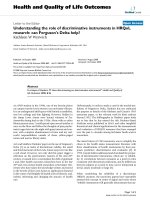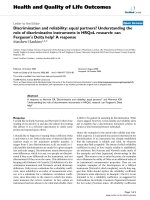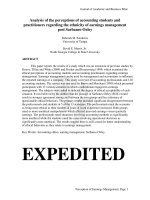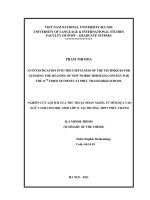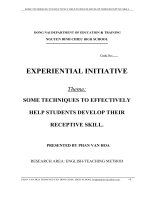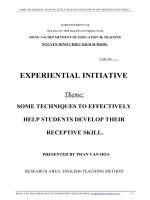SKKN what mind map activities will help students improve their understanding the meaning of words
Bạn đang xem bản rút gọn của tài liệu. Xem và tải ngay bản đầy đủ của tài liệu tại đây (1.03 MB, 30 trang )
I. INTRODUCTION
1. The need of teaching words in context
Teaching new words always plays an important part in teaching the whole
lesson. Because words are the bricks that help students build their house of
English. However, many teachers have the habit of teaching isolated words.
Actually, they have used many techniques of teaching words, but the words
presented by the teachers are not in the same contexts with the words in the
lessons. Moreover, we all know that words and phrases have different meanings
in different contexts. As a result, it is difficult for students to understand the true
meaning of the words in the lessons. In addition, students feel that it is really
difficult for them to remember the words. This leads to the fact that students are
lack of motivation for learning new words. And they feel that learning words are
really boring because there is no linking between the words in the lessons and
the words presented by the teachers. Therefore, in each lesson I have tried my
best to help my students understand the meaning of words in the lesson context
through “ mind map” activity.
2. Study’s purpose.
The purpose of this study is to find out if mind map activities help improve
students’ understanding the meaning of words. The study question is “What
mind map activities will help students improve their understanding the meaning
of words?
II. LITERATURE REVIEW
1. Definitions and terms:
To understand my area better, I have already searched some definitions and
terms related to teaching words in context so that I will have clear references.
* Teaching the meaning of words in context is suggestions found within a
sentence, a situation, or a key word that a learner can use to understand the
meanings of new or unfamiliar words.
* A mind map is a graphical way to represent ideas and concepts. It is a visual
thinking tool that helps structuring information, helping you to better analyze,
comprehend, synthesize, recall and generate new ideas. Just as in every great
idea, its power lies in its simplicity.
* A mind map is a diagram used to visually organize information. A mind map is
hierarchical and shows relationships among pieces of the whole. It is often
created around a single concept, drawn as an image in the center of a blank page,
to which associated representations of ideas such as images, words and parts of
words are added. Major ideas are connected directly to the central concept, and
other ideas branch out from those major ideas.
2. Previous study:
1
In order to find the resources to consult my issue I have read a study written by
Andana, a professor in Cukurova, Turkey. The title of this study is a guide to
teaching students . Their problem is teaching high proficiency students in high
schools and universities. Their aim is to help students understand the meaning of
words in academic situations.
After reading this research I found some strengths as well as weaknesses. The
strength of this research was that they use authentic situations and tips to teach
students. Their scaffolding activities help students to understand the situations in
which the words are . The limitation was that their research was only carried out
in classes with good students and students in their universities
However, in some ways their issue is relevant to mine. They also use the
theories of teaching the meaning of words in context.
III. METHODOLOGY.
1. Scaffolding activities.
First, students are given the key word related to the context.Then, they are
supplied some useful suggestions. Next, students are encouraged to activate
their background knowledge of words. Finally, they present the words that they
know and teachers provide some more words in context, so students can
understand the words better.
2. Data sources.
In order to answer my study question, the data needed is my students’list of
words. Because by checking my students’list of words I can see their knowledge
of words and their understanding. The purpose is to compare students’ ability to
gain the words and to remember the words before and after the method of
teaching new words in context is given.
3. Data collection
Students in class 11A1, class 11A7 and class 11A9 at Huynh Thuc Khang
high school where I was teaching were chosen for my study. Before scaffolding
activities were carried out, all students in class 11A1, 11A7, 11A9 were provided
words in normal ways and I checked their understanding. After that, students in
each class were supplied the words based on the new method (students
understand the meaning of new words in context). Teacher checks and compares
the result before and after the new method is supplied.
4. The marking scales for students’ability to undesrstand and remember
the words.
2
The following criteria is the one I find relevant to check the result.
No
Criteria
Marks
1.
Number of words that students can remember
3
2.
Using the words they have learnt in other
3
3
situations
Finding the synonyms and the antonyms of the
3
4
words that they have learnt
Classifying the words they have learnt into
1
groups
5. Data analysis:
The students’ tasks are marked based on the above criteria. The scores of
students were written down in the table below.
No
Students’ names
Scores before the
Scores after the new
new method is applied
method is applied
1
2
3
4
5
6
7
8
9
10
Basing on the table, I compared the scores of each student to know his (her)
improvement. Then the average scores of the students in each class were
calculated. The statistic was done after that. The data of the statistic showed
students’ improvement after scaffolding activities were given.
3
IV. DISCRIPTION OF THE ACTIVITIES.
* In what ways were my activities carried out?
In the school year 2018-2019, I was responsible for teaching grade 11. So, in
this paper I would like to deal with the lessons only in Textbook “ Tieng Anh
11” . Here are the description and the purpose of each activity.
Activity1:
At this state teacher led students to the context by giving the topic of the lesson
or the main content of the lesson to activate students’ background knowledge.
The reason for doing this was that students were motivated to get interest in the
topic and had ideas of words related to the topic.
Activity 2:
At this state students were given some suggested questions by the teacher, they
were step by step led to this context to another one by the teacher’s instructions.
The keys words in each lesson were underlined. And the lessons which I used “
the power point” to present, the keys words were both underlined and changed
the colour in red to make students easier to notice. In some cases, students
understood the contexts and the meaning of words, but they did not know how to
express in English, I myself helped them know what those words in English
were. As a result, their words were developed in a natural way. Therefore, they
were eager to learn new words because they found no difficulties in
understanding and remembering. Besides, this not only helped students
understand the new words but also helped students have the prediction of the
content of the lesson that they would learn.
The main technique I used for my activities were to brainstorm the ideas to fill
in the “mind map”
The following is the full description of how I helped my students understand
the meaning of words in context in each lesson in “ Tieng Anh 11”
V. TEXTBOOK ADAPTATION.
UNIT 1: FRIENDSHIP
A. READING
In this lesson, students were led to the context of “ THE FRIENDSHIP”. From
the context, I asked students some questions to activate their background
knowledge of friendship to complete a mind map.
Question 1: Do you have any friends?
From the word “ friend”, I taught my students the word “ acquaintance”.
Question. 2: What qualities are necessary for true friendship?
4
Students gave some qualities of true friendship. However, Some words were
only given in Vietnamese, I helped my students understand what those words in
English were.
* The mind map
friends
acquaintance
FRIENDSHIP
mutual
understanding
give-and-take
qualities for true
friendship
loyal
not suspicious
unselfish
UNIT 2: PERSONAL EXPERIENCES
A. READING:
From the fact that teenagers tend to have their own idols, I led students to
the context by asking questions:
1. Do you have your own idol?
2. Dou you immediate his/ her in different ways?
Students answered my questions about her/ his own idol and in what ways they
liked to immediate her own idol. After that I said that in this lesson they would
read a story about a girl who wanted to have a hat like her idol’s one. Her father
knew this and gave her some money so that she could buy the one for herself.
Next, students were divided into groups and were asked to build a story based on
the pictures in the textbook. Each student in the group who were chosen to tell
the story completed the story they had built. During the time students told
5
the story I helped them to understand the meaning of some new words based on
the pictures.
Picture d: --> idol
Picture b: --> floppy cotton hat
Picture f: --> glance--> sneaky; not making a fuss --> take the money back
C. LISTENING:
In this lesson students were led to the context of a fire. They were told to listen
to Christina who would tell the audience about her unforgettable experience that
she had witnessed. The experience was that her house caught fire during the
night time when she was very small. Then students were asked to look at the
picture in the textbook and to answer some questions to complete the “mind
map”.
Question 1: What do you think were the causes of the fire?
Question 2: How did she feel when she saw the fire?
Question 3: Who do you think she was the first person that she called when she
saw the fire?
Question 4: What did her mother do to save her?
Question 5: Was the fire a forgettable experience?
* The mind map
terrified
scream
memorable
experience
her feeling
gas stove
A HOUSE CAUGHT FIRE
causes of the fire
protect her
her mother
electricity problems
help her to escape
6
UNIT 3:
A PARTY
A. READING:
In this lesson, students were led to the context by looking the pictures in the
textbook and answering the teacher’s questions to complete the “mind map”.
Question 1:
1. On what occasions are parties held?
2. What is the relationship between the people in the pictures?
3. What are they doing?
* The mind map
a birthday party
celebrate
A PARTY
a wedding
anniversary
silver anniversary
golden anniversary
C. LISTENING:
In this lesson, students were led to the context by answering the questions in the
textbook to complete the “mind map”.
Question 1: What do you usually do to prepare your birthday party?
Question 2: What foods and drinks are often severed at your birthday party?
Question 2: What activities do you often have at your birthday party?
7
* The mind map
putting
flowers
preparing the birthday cake
with icing
prepare for a
birthday party
decorating the house
prizes
for
inviting guests
games
A BIRTHDAY PARTY
sing songs
saying
activities
birthday
cake
fruits
foods and drinks
“happy
birthday to
the host”
cutting the
birthday cakes
into slices
candies
coke
open
presents
wine
UNIT 4: VOLUNTEER WORK
A. READING:
In this lesson, students were told that they would read a passage about the
volunteer work of American students. Then students were led to the context by
answering the teacher’s questions and from the students’ answers teacher wrote
the words on the board.
Question 1: What do American students do as volunteers?
Question 2: What are the words in the passage related to the word “ volunteer”?
8
* Volunteer work:
Working in hospitals, orphanages or homes for the aged
Helping disadvantaged children or handicapped children,
give care and comfort to them.
* Volunteer (n):
Voluntary ( adj)
Voluntarily( adv)
Volunteer( v)
C. LISTENING:
In this lesson, students were told to listen to a talk about a school for
disadvantaged children in Ho Chi Minh city. Then students were asked to
answer the teacher’s questions to complete the “mind map”.
Question 1: Who are students in Spring School?
Question 2: How is money raised to support charities in Spring School?
Question 3: Who set up classes in Spring School?
* The mind map
fund-raising activities
Disadvantaged children
SPRING SCHOOL
Organisation for Educational
Development co-operates with
Spring School set up the classes
9
UNIT 6:
COMPETITIONS
A. READING:
In this lesson, students were told that they would read a passage about an
English competition in a high school. Then students were led to the context by
answering the questions to complete the “mind map”.
Question 1: How often is the English competition held in your school?
Question 2: What is the purpose of the competition?
Question 3: What do we call in English the students who are chosen to take part
in the competition?
* The mind map
to stimulate the spirit of learning
English among students
the purpose
ENGLISH
COMPETITION
representatives
every two years
students chosen to take
part in the competition
how often
every year
( yearly)
10
UNIT 7: WORLD POPULATION
A. READING.
In this lesson, students were told that they would read a passage about WOLRD
POPULATION. Then students were led to the context by answering the
questions to complete the “mind map”
Question 1: Do you know what the population of the world in 1850, 1950, 1985,
and 2000?
Question 2: Can women in the world limit the size of their families?
Question 3: How does the government help them in family planning?
* The mind map
6,600,000,000
1,300,000,000
in 1850
safe birth-control
methods
the population
reached the
figure of
2,510,000 ,000
in 1950
WORLD
POPULATION
the
government
help the
women limit
the size of
their
families
B. SPEAKING.
In this lesson, students were told that they would talk about WOLRD
POPULATION. Then students were led to the context by answering the
questions to complete the “mind map”
Question 1: What are the causes of population explosion?
Question 2: Can you list the problems facing poor and overpopulated countries?
Question 3: Can you suggest the solutions to the problems of overpopulation?
11
* The mind map
not aware of the problem
a large family is of overpopulation a form of
insurance
causes of population
religion
explosion
WOLRD
POPULATION
raise awareness
poor conditions
solutions
use birthcontrol method
problems
facing
lack/ shortage of
school/ hospital/
teacher/ doctor......
implement reward
and punishment
policies
12
C. LISTENING
In this lesson, students were told to listen to a world population expert talking
about the world population. Then students were asked to answer the teacher’s
questions to complete the “mind map”.
Question 1: Which country has the population ranked the first?
Question 2: What problem does population explosion cause to the world?
* The mind map
China ranks the first
illiteracy
problems population
WOLRD POPULATION
explosion cause to the
world
lack of hospitals and schools/
shortage of food / poor living
conditions particularly in
developing countries
UNIT 8: CELEBRATIONS
A. READING
In this lesson, students were watched to a video clip about Tet. Then students
were asked to answer the teacher’s questions to complete the “mind map”.
Question 1: When is Tet?
Question 2: What activities do people usually do at Tet?
Question 3:What are special things at Tet?
Question 4: What do people prepare for Tet?
13
* The mind map
visit
relatives
eating special
foods
for agrarian people,
the start of a new year
activities
receiving
lucky money
when
grandest
and most
important
occasion
go to pagoda
to pray
between 19th January
and 20th February
TET
flowers ( apricot
blossom, peach
blossom)
streets decorated
with colored lights
and red banners
special
things
preparations
Banh
chung
decorating the house
candied fruits
( sugared
apples, plums)
B. SPEAKING
In this lesson, students were told that they would talk about popular holidays
and celebrations in Vietnam and in the world. Then students were asked to look
at the pictures in the textbook and answer the teacher’s questions to complete
the “mind map”.
14
Question 1: What are the holidays and celebrations?
Question 2: What is the purpose of each celebration?
Question 3: What are main activities in each celebration?
* The mind map
celebrate the
harvest
Thanks giving
celebrate the
largest full moon
a large meal with
roast turkey
POPULAR CELEBRATIONS
IN VIETNAM AND IN THE
WORLD
Mid- Autumn
Festival
children wear
masks, parade
in the streets
valentine’s Day
express their love
give chocolates,
flowers or gifts to the
people they love
C. LISTENING
In this lesson, students were told to listen to how people celebrate the New Year
in Japan. Then students were asked to answer the teacher’s questions to
complete the “mind map”.
Question 1: What activities do people usually do on New Year Days in Japan?
Question 2:What are special things on New Year Days in Japan?
Question 3: What do people prepare on New Year in Japan?
15
* The mind map
put on special clothes
activities
go to shrines
to pray
decorate the
house with pine
trees which
presents longevity
and constancy
NEW
YEAR IN
JAPAN
wine
preparations
special things
watch TV
clean the house
UNIT 9: THE POST OFFICE
A. READING
In this lesson, students were told that they would read a passage about Thanh
Ba post office. Then students were asked to answer the teacher’s questions to
complete the “mind map”.
Question 1: What services do you think the post office offers?
Question 2: What do you know about fax machine?
Question 3: Who do you work with when you go to the post office?
16
* The mind map
phone call
and faxes
mail and parcel service
press distribution
the post
office staff
services
THE POST OFFICE
courteous
( helpful)
express ( very fast/
speedy)money transfer
fax machine
not lose its
original
shape
send a document
C. LISTENING
In this lesson, students were told to listen to some information about the
development of Vietnam’s telephone system over the past few years. Then
students were asked to answer the teacher’s questions to complete the “mind
map”.
Question 1: How has Vietnam developed its telephone system over the past few
years ?
Question 3: What do you know about the mobile phone system in Vietnam?
17
* The mind map
upgrade its
more than
2,000,000
suscribers
changing
numbers
from 6 to 7
digits in
many
provinces
telephone system
the growth in
the capacity of
the mobile
system
VIETNAM’S TELEPHONE
SYSTEM OVER THE PAST FEW
YEARS
develop the
almost communes have rural network post offices
UNIT 10: NATURE IN DANGER
A. READING
In this lesson, students were told that they would read a passage about THE
NATURE IN DANGER. . Then students were asked to answer the teacher’s
questions to complete the “mind map”.
Question : What have human beings done with the environment, animals and
plants?
18
* The mind map
extinct
buildings and villages
instead of forests
killed
animals
NATURE IN DANGER
environment’s
interference
endangered
adding species pollutants to it
plants
cutting down
flood and drought
B. SPEAKING
In this lesson, students were watched some pictures about some reasons why
nature is threatened. Then students were asked to answer the teacher’s questions
to complete the “mind map”.
* The mind map
hunting or capturing
animals for recreation
and entertainment
killed for fur, skin,
and food
THE REASONS WHY
NATURE IS
THREATENED
using fertilizers and
pesticides for
discharging chemicals cultivation pollutants
19
C. LISTENING
In this lesson, students were told to listen to the tape about National Parks in
America . Then students were asked to answer the teacher’s questions to
complete the “mind map”.
Question 1: What are the purposes of the National Parks?
Question 2: Can you list some reasons why National Parks are destroyed?
* The mind map
contain a variety of
scenic features
pollution from
vehicles
devastating fires
purposes
the reasons why
National Parks
are destroyed
NATIONAL PARKS
preserve the
natural beauty
of land
animals are
killed
trees are
cut down
UNIT 11: SOURCES OF ENERGY
A. READING
In this lesson, students were told that they would read a passage about
SOUCES OF ENERGY. Then students were asked to look at the pictures and
answer the teacher’s questions to complete the “mind map”.
Question 1: What source of energy does each picture refer to?
Question 2: What is advantage and disadvantage of each picture?
20
* The mind map
alternative
available
clean and
safe
dangerous
nuclear power
solar energy
limited
alternative
SOURCES OF ENERGY
fossil fuels
clean and safe
water power
wind power
exhausted in a
relative short time
expensive
no wind,
no energy
C. LISTENING
In this lesson, students were told to listen to the tape about natural environment .
Then students were asked to answer the teacher’s questions to complete the
“mind map”.
Question 1: What is natural environment?
Question 2: How many groups are resources divided into?
21
The mind map
the ecologists study their
importance
important ( vital)
the air
the oceans
the sun
the land
NATURAL RESOUCES
renewable
divided into two groups
non-renewable
UNIT 12: THE ASIAN GAMES
A. READING
In this lesson, students were told that they would read a passage about THE
ASIAN GAMES. Then students were asked to answer the teacher’s questions to
complete the “mind map”.
Question 1: What is the purpose of the Asian Games?
Question 2: How have the Asian Games been through the history?
Question 3: How do Vietnamese athletes compete in different sports?
22
* The mind map
sports skill are
tested
friendship and
solidarity
advancing in all
aspects
purposes
THE ASIAN GAMES
Asian Games
through the
history
facilities
developed
with great
efforts
Vietnamese athletes
with great
enthusiasm
C. LISTENING
In this lesson, students were told to listen to the tape about THE ASIAN GAME
REPORT . Then students were asked to look at the pictures and answer the
teacher’s questions to complete the “mind map”.
Question 1: What kind of sport in the third picture? What do we call the player
in English ?
Question 2: What is it under the man’s back in the first picture? What is he
going to do?
Question 3: What kind of sports in the second picture?
23
* The mind map
bar
picture 1
coming live
is going to
land
THE ASIAN GAMES
REPORT
picture 3
gymnasium
freestyle
picture 2
gymnast
UNIT 13: HOBBIES
A. READING
In this lesson, students were told that they would read a passage about
HOBBIES. Then students were asked to look at the pictures in the textbook
and answer the teacher’s questions to complete the “mind map”.
Question 1: What do people like doing in the picture 1?
Question 2: What do people like doing in the picture 2?
Question 3: What do people like doing in the picture 3?
Question 4: What do people like doing in the picture 4?
Question 5: What do people like doing in the picture 5?
Question 6: What do people like doing in the picture 6?
24
* The mind map
Do you like accompanying
people with your guitar?
collecting
stamps
playing guitar
where do you collect
stamps? ( from
discarded envelopes)
very good (accomplished)
guitarist
HOBBIES
swimming
playing chess
keeping fish
Is it a small ( modest)
fish tank?
Do your hobbies keep you
occupied?
C.LISTENING
In this lesson, students were told to listen to the tape about a student talking
about his hobbies ( reading books) and when she was small her parents used
to read fairy tales to him . Then students were asked to answer the teacher’s
questions.
Question 1: Do you like fairy tales?
Question 2: What do you learn from reading books? - How people lived bygone days.
- Wonders of the world.
- Gigantic fish in the sea.
- Better equipped to cope with living.
25


